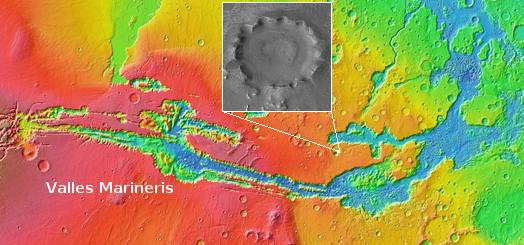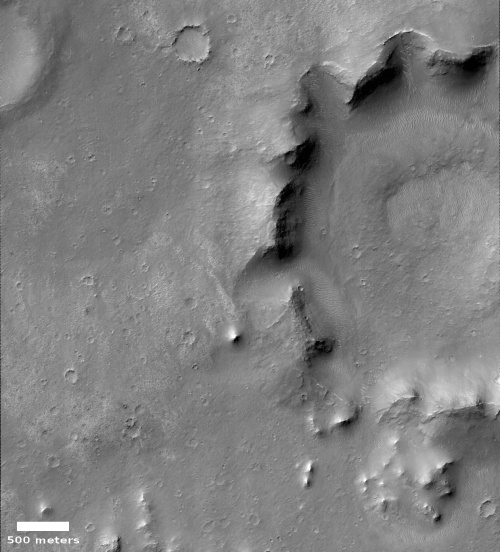A Martian crater with a very weird rim
In looking through new images from Mars Reconnaissance Orbiter (MRO), I sometimes stumble some very strange things, with today’s cool image an example. The picture to the right, rotated, cropped, and reduced to post here, was taken on May 7, 2023 by MRO’s high resolution camera, and shows the western half of a two-mile-wide crater with a very weird rim, almost as if a person had decided he wanted to reshape it with a filigree pattern.
Though only two-miles wide, this crater actually has been named Johnstown. I suspect this is because of its strange rim, prompting a research effort and the need to provide it a name. Why the rim has this repeating pattern of gaps, however, is beyond my pay grade to explain, and I have been unable to track down any research papers about it. The nearby surrounding surface suggests vaguely the possibility that this is a caldera, not an impact crater, but even so why would the rim of the caldera have these regular breaks?

The white dot marks the location of the crater, inside larger 50-mile-wide Morella Crater. The inset, created from a mosaic of MRO context camera pictures, shows the rest of Johnstown Crater at lower resolution.
The south rim of Morella is itself cut by Ganges Cavus, a 25-mile-wide basin 15,000 feet deep. With no outlets or drainage features, Ganges Cavus looks very much like a giant sinkhole, created when the surface slumped down into a void below. There are a number of these titanic sinkholes surrounding Valles Marineris. Similarly, the fissures in Noctis Labyrinthus to the west, the likely source of this grand canyon, also appear to be made of sinkholes.
Taken together, these sinks strongly suggest that Valles Marineris was first created by an underground flow that created a void, which then became a sink, and finally become the canyon we see now.
On Christmas Eve 1968 three Americans became the first humans to visit another world. What they did to celebrate was unexpected and profound, and will be remembered throughout all human history. Genesis: the Story of Apollo 8, Robert Zimmerman's classic history of humanity's first journey to another world, tells that story, and it is now available as both an ebook and an audiobook, both with a foreword by Valerie Anders and a new introduction by Robert Zimmerman.
The print edition can be purchased at Amazon or from any other book seller. If you want an autographed copy the price is $60 for the hardback and $45 for the paperback, plus $8 shipping for each. Go here for purchasing details. The ebook is available everywhere for $5.99 (before discount) at amazon, or direct from my ebook publisher, ebookit. If you buy it from ebookit you don't support the big tech companies and the author gets a bigger cut much sooner.
The audiobook is also available at all these vendors, and is also free with a 30-day trial membership to Audible.
"Not simply about one mission, [Genesis] is also the history of America's quest for the moon... Zimmerman has done a masterful job of tying disparate events together into a solid account of one of America's greatest human triumphs."--San Antonio Express-News
In looking through new images from Mars Reconnaissance Orbiter (MRO), I sometimes stumble some very strange things, with today’s cool image an example. The picture to the right, rotated, cropped, and reduced to post here, was taken on May 7, 2023 by MRO’s high resolution camera, and shows the western half of a two-mile-wide crater with a very weird rim, almost as if a person had decided he wanted to reshape it with a filigree pattern.
Though only two-miles wide, this crater actually has been named Johnstown. I suspect this is because of its strange rim, prompting a research effort and the need to provide it a name. Why the rim has this repeating pattern of gaps, however, is beyond my pay grade to explain, and I have been unable to track down any research papers about it. The nearby surrounding surface suggests vaguely the possibility that this is a caldera, not an impact crater, but even so why would the rim of the caldera have these regular breaks?

The white dot marks the location of the crater, inside larger 50-mile-wide Morella Crater. The inset, created from a mosaic of MRO context camera pictures, shows the rest of Johnstown Crater at lower resolution.
The south rim of Morella is itself cut by Ganges Cavus, a 25-mile-wide basin 15,000 feet deep. With no outlets or drainage features, Ganges Cavus looks very much like a giant sinkhole, created when the surface slumped down into a void below. There are a number of these titanic sinkholes surrounding Valles Marineris. Similarly, the fissures in Noctis Labyrinthus to the west, the likely source of this grand canyon, also appear to be made of sinkholes.
Taken together, these sinks strongly suggest that Valles Marineris was first created by an underground flow that created a void, which then became a sink, and finally become the canyon we see now.
On Christmas Eve 1968 three Americans became the first humans to visit another world. What they did to celebrate was unexpected and profound, and will be remembered throughout all human history. Genesis: the Story of Apollo 8, Robert Zimmerman's classic history of humanity's first journey to another world, tells that story, and it is now available as both an ebook and an audiobook, both with a foreword by Valerie Anders and a new introduction by Robert Zimmerman.
The print edition can be purchased at Amazon or from any other book seller. If you want an autographed copy the price is $60 for the hardback and $45 for the paperback, plus $8 shipping for each. Go here for purchasing details. The ebook is available everywhere for $5.99 (before discount) at amazon, or direct from my ebook publisher, ebookit. If you buy it from ebookit you don't support the big tech companies and the author gets a bigger cut much sooner.
The audiobook is also available at all these vendors, and is also free with a 30-day trial membership to Audible.
"Not simply about one mission, [Genesis] is also the history of America's quest for the moon... Zimmerman has done a masterful job of tying disparate events together into a solid account of one of America's greatest human triumphs."--San Antonio Express-News



I wonder if it was called Johnstown because it looks like it was flooded?
https://en.m.wikipedia.org/wiki/Johnstown_Flood